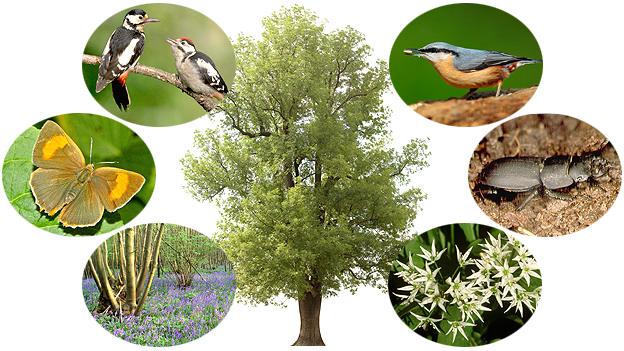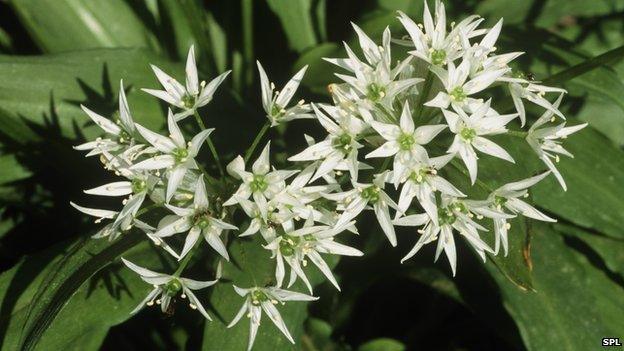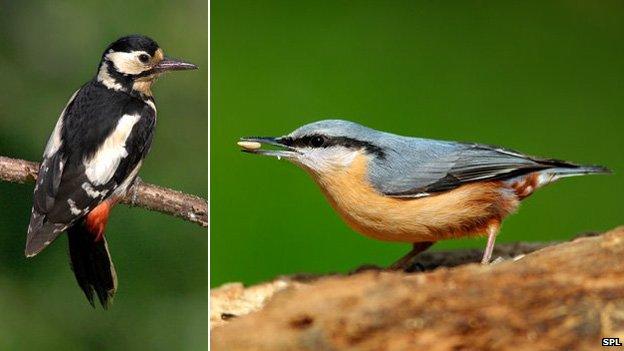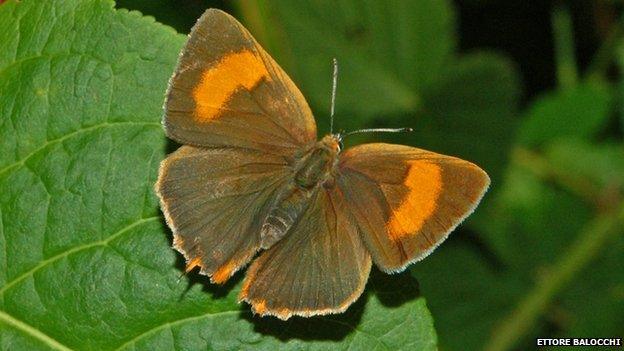Ash dieback: What will be rising from the ashes?
- Published

Results of a nationwide survey revealed the disease was present at sites around the UK
Environment Secretary Owen Paterson has acknowledged that ash dieback is in the UK to stay.
Since it was first confirmed at a Buckinghamshire nursery in March, the number of cases has slowly increased.
And in late October, ecologists' fears were realised when an important barrier was breached - it was found in the wider environment and the UK's 80 million ash trees were at risk.
The news last month that the disease, caused by the fungus Chalara fraxinea, had been found in woodlands in East Anglia prompted Mr Paterson to impose an import ban on ash trees, and to carry out a nationwide survey to find out how far the disease had spread.
He also convened an emergency summit, bringing together "key stakeholders", to consider what could be done. The resulting action plan, agreed at an emergency Cobra meeting, outlined where the government would focus its efforts.
The plan seems to be pinning a great deal of hope on scientists finding natural resistance within the UK's population of ash trees.
Once identified, researchers would then look to grow the next generation of ash trees that would be resilient to the pathogen.
One of the government's leading scientists, Prof Ian Boyd, is optimistic.
He told journalists: "By next season, we could potentially have resistant forms of ash growing in this country."
Mind the gap
But ash trees, while considered fast-growing within the world of hardwood trees, take decades to reach maturity and produce the seeds that would sow naturally resistant trees.
In the interim, ash dieback will continue to spread and trees would continue to become infected and not be replaced, as Dr Pocock explained.
How ash dieback could threaten Britain's wildlife

Britain's population of 80 million ash trees provides shelter and food for a wide range of wildlife, mostly birds and insects. The species' loosely-branched structure means plenty of light reaches the woodland floor, allowing a variety of plants to grow beneath them.

Wild garlic (ramsons) is among the plants that thrives beneath the ash tree. Others include dog's mercury, wood cranesbill, wood avens and hazel. Because ash bark is alkaline, the trees also support a wide range of lichens and mosses and attract snails.

Carpets of bluebells are often seen under and around ash trees. Norfolk’s Lower Wood, in Ashwellthorpe, famous for its spring display of bluebells, is among those areas where ash dieback disease has been discovered.

A rich ground layer beneath the ash means plenty of food for birds such as warblers, flycatchers and redstarts. Hole-nesting birds, such as owls, woodpeckers and the nuthatch, are also frequent visitors.

More than 100 species of insect are also known to live on ash. At least 60 of the rarest have an association with the tree – mostly beetles and flies. Because ash is very long-lived, it can also support specialist deadwood species, like the lesser stag beetle.

The brown hairstreak butterfly, the largest of the UK hairstreaks, is also a frequent user of the ash. They congregate high in the trees for breeding. Ash also supports a wide variety of moths. Source: The Wildlife Trusts
"Those that are susceptible to the disease will get hit, and those that are not or less susceptible will go on and will be able to fruit. That is the process of natural selection," he told BBC News.
"But the process of natural selection on trees will operate on much longer timescales.
"If there was a disease that affected an annual plant, the selection pressure on that plant would be such that you would get resistance, and then you would get the spread of the resistant [offspring of the plant].

Weeping ash: The future looks at best uncertain for the UK's population of 80 million ash trees
"You would see a dip in that species population for a couple of years, and then it would be likely to recover," Dr Pocock explained.
"You would expect to see the same thing in trees, but the timescale is at least decades rather than months or years."
So would ecosystems be able to cope with the loss of ash trees from the landscape while the naturally resistant trees matured?
RSPB forestry officer Nick Phillips said UK woodlands were already in trouble.
"The important point to remember here is that woodland wildlife is already in crisis," he told BBC News.
"One in six woodland flowers is threatened with extinction. Our woodland butterflies have halved since the 1990s. Many of our woodland birds have declined by 70% or more.
"This is not the result of tree disease, this is something that has already been going on for some time.
"Our woodland wildlife is already stressed and we don't know yet what effect additional stress will have on it."
Mission impossible
And the outbreak is already shaping the future, as tree managers weigh up the risk of planting ash in woodlands.
This year saw the Woodland Trust create 59 Diamond Woods and its flagship 460-acre (186ha) Diamond Park in Leicestershire to mark the Queen's Diamond Jubilee.
A spokesman told BBC News that, in light of the news that the disease was here to stay, the Trust had taken the decision that it would suspend planting ash saplings and substitute them with other native species.
He added that now that the planting season was opening, there were plans to plant three million trees over the coming months.
"As it stands, we are running all tree planting events as normal. We will substitute any ash saplings for either oak, birch or possible shrubs such as hazel, dependent on the location and what fits best within the current landscape."
And the concern about planting new ash trees is spreading.
Brighton is famed for being home to veteran elms that did not fall victim to the outbreak of Dutch elm disease, thanks to the combination of the city's geographical location and a very robust tree management regime.
However, a spokeswoman for Brighton and Hove Council said such an approach would not work to prevent ash dieback infecting trees.
"The recent outbreak of ash dieback is spread by the wind, and this type of dispersal is impossible to protect against.
"At present, we are not purchasing any ash trees and would avoid the species until we know more about the disease."
So until scientists make a breakthrough and can propagate ash dieback-resistant trees, the situation for ash - a popular street tree - is likely to get worse before it gets better.
Ash is one of just 30-odd native tree species, making the thought of losing it from the landscape a difficult pill to swallow for many people.
"It is very difficult to predict what the impact will be if ash dieback is as serious as the worst fears," Centre for Ecology and Hydrology ecologist Michael Pocock observed.
"The vast majority if not all ecologists will be [recording the spread and impact of the disease] with a heavy heart because, ultimately, we are not ecologists to chart the progress of doom - we are ecologists because we care about the environment and we want to do something positive."